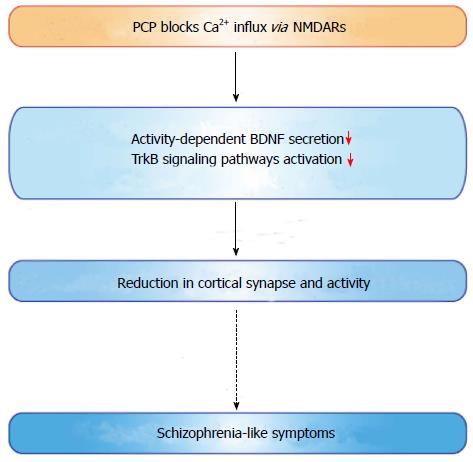Copyright
©2014 Baishideng Publishing Group Inc.
World J Biol Chem. Nov 26, 2014; 5(4): 409-428
Published online Nov 26, 2014. doi: 10.4331/wjbc.v5.i4.409
Published online Nov 26, 2014. doi: 10.4331/wjbc.v5.i4.409
Figure 1 Schematic illustration of the activity-dependent regulators for Brain-derived neurotrophic factor gene transcription.
A variety of transcriptional factors and regulators participate in the activity-induced transcription of BDNF. BDNF gene structure and Ca2+-dependent regulation in BDNF exon IV and epigenetic regulation at the exon IX promoter region are presented. We referred to the description by Zheng et al[38], also see[180]. BDNF: Brain-derived neurotrophic factor; CaRF: Calcium responsive factor; USF: Upstream stimulatory factors; BHLHB: Basic helix-loop-helix; CREB: Cyclic AMP-responsive element binding protein; NFκB: Nuclear factor-κB.
Figure 2 Schematic illustration of activity-dependent brain-derived neurotrophic factor secretion.
A possible mechanism of intracellular Ca2+-dependent secretion of BDNF suggested in literature. Ca2+ influx through NMDA receptor/L-type VGCC and subsequent Ca2+ release of internal stores via ryanodine receptors are required for secretion. CaMKII, PKA, synaptotagmin IV, and CAPS2 also critically contribute to the membrane fusion process of BDNF-containing vesicles. VGCC: L-type voltage-gated calcium channels; CaMKII: calcium/calmodulin-dependent protein kinase II; PKA: protein kinase A; CAPS2: Ca2+-dependent activator protein for secretion 2; BDNF: Brain-derived neurotrophic factor.
Figure 3 Molecular mechanisms of phencyclidine-induced synaptic loss as a cellular model of schizophrenia.
Phencyclidine decreased the number of synaptic sites in cultured cortical neurons through blockade of Ca2+ influx via NMDARs and resultant suppression of BDNF secretion. The impairment in BDNF secretion reduced TrkB activation and resulted in decreased synaptic connectivity[15]. BDNF: Brain-derived neurotrophic factor; NMDAR: N-methyl-D-aspartate receptors; PCP: Phencyclidine.
- Citation: Adachi N, Numakawa T, Richards M, Nakajima S, Kunugi H. New insight in expression, transport, and secretion of brain-derived neurotrophic factor: Implications in brain-related diseases. World J Biol Chem 2014; 5(4): 409-428
- URL: https://www.wjgnet.com/1949-8454/full/v5/i4/409.htm
- DOI: https://dx.doi.org/10.4331/wjbc.v5.i4.409











